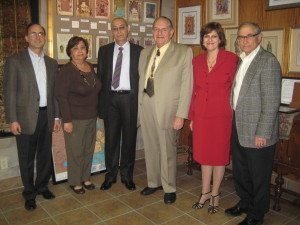On Dec. 6, 2009, Dr. Pavel Avetisyan, the director of Armenia’s Institute of Archaeology and Anthropology, and Dr. Gregory Areshian of the Cotsen Institute of Archaeology at UCLA, presented illustrated lectures at the Ararat-Eskijian Museum in Mission Hills, Calif. The event was co-sponsored by the museum, the Friends of UCLA Armenian Language and Culture Studies, and the National Association for Armenian Studies and Research (NAASR).

Avetisyan spoke in Armenian, with English translation provided by Areshian, on the subject “International Academic Cooperation and Its Importance for Studies in Armenian History and Civilization.” He explained that a major transformation of Armenian studies has taken place during the last two decades since Armenia gained independence from the Soviet Union. Besides traditional areas such as the study of the Armenian past based on written historical records and Armenian literature, “younger” areas of inquiry more focused on the Armenian material cultural heritage, long-term processes in Armenian history, anthropological and sociological researches, and others started gaining momentum.
“It is not surprising that the Institute of Archaeology and Anthropology of the National Academy of Sciences of the Republic of Armenia has become the world’s fastest growing institution of Armenian studies,” Avetisyan said. The institute focuses on previously unexplored or poorly understood areas of Armenian life and civilization: from the appearance of the first humans on the Armenian Highland to the formation of values and the transformation of national identities in contemporary Armenian society at the threshold of the new millennium.
What propels this growth, said Avetisyan, is the exponential expansion of international cooperation. Currently the institute is the senior partner in two dozen international collaborative projects, the largest 11 of which are concerned with the study and documentation of the Ancient and Medieval Armenian material cultural heritage. In the last six to seven years, these projects have made amazing discoveries, some of which Avetisyan presented.
In his view, the most significant implications of the international collaboration are: (1) that the most recent advances in social theory developed in the West are applied to the social researches in Armenia; (2) the Armenian cultural heritage is brought to the attention of scholarly audiences and the general public in the U.S. and Europe; (3) new discoveries not only make major corrections and fill gaps in our knowledge of Armenian history, but also contribute to a better understanding of significant stages in the development of human civilization; (4) a major improvement in the training of students in Armenia has been achieved; (5) Armenian society has been enriched by a large number of new sites, monuments, and findings of cultural and historical value, all of which are kept in different museums in Armenia; and (6) the scientific data obtained during those explorations are processed and studied in the best laboratories of Europe and North America.
Areshian, in a talk in English entitled “The Discovery of a 6,000 Year-Old Cave Civilization in Armenia,” presented information connected with discoveries made during 2007-09 in the Vayots-Dzor Province by the Arpa River Valley Joint Project of the Institute of Archaeology and Anthropology of the National Academy of Sciences of Armenia and the Cotsen Institute of Archaeology at the University of California, Los Angeles.
The Arpa River Valley is a little-explored area, despite having the highest concentration of karstic caves in Armenia and such outstanding monuments of Armenian medieval architecture as the Noravank Monastery. The project identified more than three dozen inhabited caves in that region and other important sites dating from the Stone Age to the 17th century A.D. In the summer of 2010, the Project will start a systematic survey of the region.
For Areshian, however, the most exciting and sensational discoveries were made at the cave known as Areni-1, where a small-scale excavation began in 2007. The explorations carried out thus far attest to a very large site with cultural remains in three interconnected cave galleries, each up to 40 meters long, and also under the rock shelter in front of the galleries and on the slope descending toward the river. In the uppermost layer, fragments of a Medieval Armenian manuscript were found. Beneath, a carbonated, hard, and natural crust covered more than 15-feet-thick cultural layers.
The crust, together with extreme dryness and stable temperatures inside, created unique conditions that preserved artifacts and various organic remains not found in other earlier excavations. Non-burnt wooden artifacts, seeds, rope, cloth, straw, grass, reeds, and even dried fruits (grapes and prunes) were found in the top three layers dating back to the Copper Age (Chalcolithic), ca. 4,000 B.C. Various remains may indicate the presence of a full cycle of wine making in the cave.
Areshian explained that a human brain found in a ritually deposited head is the most astounding discovery from that period. This is the oldest human brain ever found in the Old World. He stated that the newly discovered cave society will prompt a major revision of our knowledge concerning the early civilizations of the Middle East and southeastern Europe.
For more information on the talks by Avetisyan and Areshian, contact the Ararat-Eskijian Museum by calling (818) 838-4862 or emailing ararat-eskijian-museum@netzero.net; the Friends of UCLA Armenian Studies by calling (310) 704-4353; or NAASR by calling (617) 489-1610 or emailing hq@naasr.org.


Be the first to comment